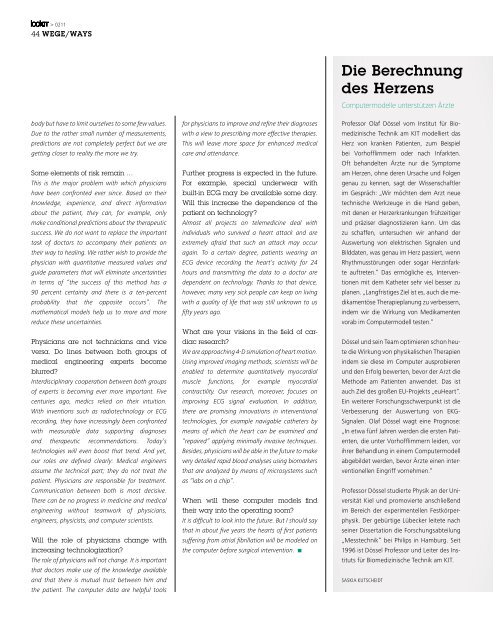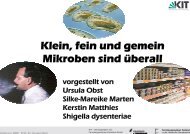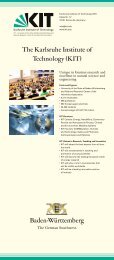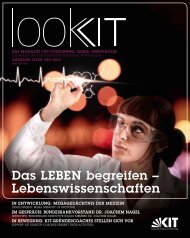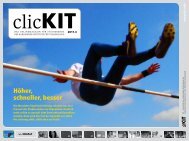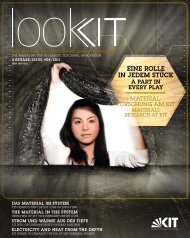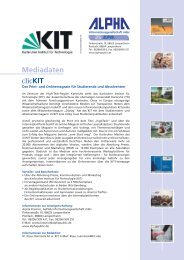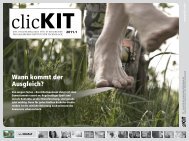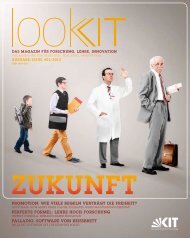lookKIT 02/2011 - PKM - KIT
lookKIT 02/2011 - PKM - KIT
lookKIT 02/2011 - PKM - KIT
Sie wollen auch ein ePaper? Erhöhen Sie die Reichweite Ihrer Titel.
YUMPU macht aus Druck-PDFs automatisch weboptimierte ePaper, die Google liebt.
<strong>02</strong>11<br />
44 wege/Ways<br />
Die Berechnung<br />
des Herzens<br />
Computermodelle unterstützen Ärzte<br />
body but have to limit ourselves to some few values.<br />
Due to the rather small number of measurements,<br />
predictions are not completely perfect but we are<br />
getting closer to reality the more we try.<br />
Some elements of risk remain …<br />
This is the major problem with which physicians<br />
have been confronted ever since. Based on their<br />
knowledge, experience, and direct information<br />
about the patient, they can, for example, only<br />
make conditional predictions about the therapeutic<br />
success. We do not want to replace the important<br />
task of doctors to accompany their patients on<br />
their way to healing. We rather wish to provide the<br />
physician with quantitative measured values and<br />
guide parameters that will eliminate uncertainties<br />
in terms of “the success of this method has a<br />
90 percent certainty and there is a ten-percent<br />
probability that the opposite occurs”. The<br />
mathematical models help us to more and more<br />
reduce these uncertainties.<br />
Physicians are not technicians and vice<br />
versa. Do lines between both groups of<br />
medical engineering experts become<br />
blurred?<br />
Interdisciplinary cooperation between both groups<br />
of experts is becoming ever more important. Five<br />
centuries ago, medics relied on their intuition.<br />
With inventions such as radiotechnology or ECG<br />
recording, they have increasingly been confronted<br />
with measurable data supporting diagnoses<br />
and therapeutic recommendations. Today’s<br />
technologies will even boost that trend. And yet,<br />
our roles are defined clearly: Medical engineers<br />
assume the technical part; they do not treat the<br />
patient. Physicians are responsible for treatment.<br />
Communication between both is most decisive.<br />
There can be no progress in medicine and medical<br />
engineering without teamwork of physicians,<br />
engineers, physicists, and computer scientists.<br />
Will the role of physicians change with<br />
increasing technologization?<br />
The role of physicians will not change. It is important<br />
that doctors make use of the knowledge available<br />
and that there is mutual trust between him and<br />
the patient. The computer data are helpful tools<br />
for physicians to improve and refine their diagnoses<br />
with a view to prescribing more effective therapies.<br />
This will leave more space for enhanced medical<br />
care and attendance.<br />
Further progress is expected in the future.<br />
For example, special underwear with<br />
built-in ECG may be available some day.<br />
Will this increase the dependence of the<br />
patient on technology?<br />
Almost all projects on telemedicine deal with<br />
individuals who survived a heart attack and are<br />
extremely afraid that such an attack may occur<br />
again. To a certain degree, patients wearing an<br />
ECG device recording the heart’s activity for 24<br />
hours and transmitting the data to a doctor are<br />
dependent on technology. Thanks to that device,<br />
however, many very sick people can keep on living<br />
with a quality of life that was still unknown to us<br />
fifty years ago.<br />
What are your visions in the field of cardiac<br />
research?<br />
We are approaching 4-D simulation of heart motion.<br />
Using improved imaging methods, scientists will be<br />
enabled to determine quantitatively myocardial<br />
muscle functions, for example myocardial<br />
contractility. Our research, moreover, focuses on<br />
improving ECG signal evaluation. In addition,<br />
there are promising innovations in interventional<br />
technologies, for example navigable catheters by<br />
means of which the heart can be examined and<br />
“repaired” applying minimally invasive techniques.<br />
Besides, physicians will be able in the future to make<br />
very detailed rapid blood analyses using biomarkers<br />
that are analyzed by means of microsystems such<br />
as “labs on a chip”.<br />
When will these computer models find<br />
their way into the operating room?<br />
It is difficult to look into the future. But I should say<br />
that in about five years the hearts of first patients<br />
suffering from atrial fibrillation will be modeled on<br />
the computer before surgical intervention.<br />
Professor Olaf Dössel vom Institut für Biomedizinische<br />
Technik am <strong>KIT</strong> modelliert das<br />
Herz von kranken Patienten, zum Beispiel<br />
bei Vorhofflimmern oder nach Infarkten.<br />
Oft behandelten Ärzte nur die Symptome<br />
am Herzen, ohne deren Ursache und Folgen<br />
genau zu kennen, sagt der Wissenschaftler<br />
im Gespräch: „Wir möchten dem Arzt neue<br />
technische Werkzeuge in die Hand geben,<br />
mit denen er Herzerkrankungen frühzeitiger<br />
und präziser diagnostizieren kann. Um das<br />
zu schaffen, untersuchen wir anhand der<br />
Auswertung von elektrischen Signalen und<br />
Bilddaten, was genau im Herz passiert, wenn<br />
Rhythmusstörungen oder sogar Herzinfarkte<br />
auftreten.“ Das ermögliche es, Interventionen<br />
mit dem Katheter sehr viel besser zu<br />
planen. „Langfristiges Ziel ist es, auch die medikamentöse<br />
Therapieplanung zu verbessern,<br />
indem wir die Wirkung von Medikamenten<br />
vorab im Computermodell testen.“<br />
Dössel und sein Team optimieren schon heute<br />
die Wirkung von physikalischen Therapien<br />
indem sie diese im Computer ausprobieren<br />
und den Erfolg bewerten, bevor der Arzt die<br />
Methode am Patienten anwendet. Das ist<br />
auch Ziel des großen EU-Projekts „euHeart“.<br />
Ein weiterer Forschungsschwerpunkt ist die<br />
Verbesserung der Auswertung von EKG-<br />
Signalen. Olaf Dössel wagt eine Prognose:<br />
„In etwa fünf Jahren werden die ersten Patienten,<br />
die unter Vorhofflimmern leiden, vor<br />
ihrer Behandlung in einem Computermodell<br />
abgebildet werden, bevor Ärzte einen interventionellen<br />
Eingriff vornehmen.“<br />
Professor Dössel studierte Physik an der Universität<br />
Kiel und promovierte anschließend<br />
im Bereich der experimentellen Festkörperphysik.<br />
Der gebürtige Lübecker leitete nach<br />
seiner Dissertation die Forschungsabteilung<br />
„Messtechnik“ bei Philips in Hamburg. Seit<br />
1996 ist Dössel Professor und Leiter des Instituts<br />
für Biomedizinische Technik am <strong>KIT</strong>.<br />
Saskia Kutscheidt


